Industrial electric motors are the “life blood” of your plant’s operation. The theoretical design life of an electric motor is 20 years or more. Yet many tens of thousands of industrial electric motors end up in the trash pile prematurely. This results in an enormous loss for industries across the board.
In this article, we will go over six points on how to keep your electric motors running properly and to maximize their life cycle. Follow these tips and you should see sustained performance with this vital piece of plant equipment.
1. Lubricate Properly
Motor lubrication guides (either OEM or by grease suppliers) typically rely on the “owner” to operate the motor in ideal or near ideal conditions. The “best practice” is to keep the motor, shaft, and bearing assembly clean, dry, aligned, and serviced to minimize vibration and shock load.
In this section, we will outline how to ensure that the bearings on your electric motor are properly lubricated in less than ideal conditions. Several professional organizations (such as EPRI and STLE) have identified that 50-60% of motor failures are a result of premature bearing failure due to inadequate lubrication practices.
Don’t over lubricate your bearings
Over lubrication can cause the grease or oil to get into the windings. This will cause the insulation to deteriorate around the winding, resulting in arcing and shorting inside the motor to the case. Over lubrication will also cause excessive heat and wear on the rotor and stator.
Re-greasing requires best practices for today and your specific service environment. Be wary of using OEM manuals that might have been created years ago and might not be relevant to the current available technology and procedural recommendations.
You can avoid over greasing with the use of ultra sonic or acoustical monitoring during the re-greasing process. Listen to the bearing and stop greasing when the acoustical signal indicates that the bearing contact surfaces have been adequately replenished with fresh lubricant.
Another technique and considered “best practice” is to always remove the bottom drain plug from the bearing housing during re-greasing and to re-grease whilst the motor is running. This enables fresh grease to be fully incorporated into the housing and bearing surfaces by the natural “pumping action” of the rotating bearing. This action, in turn, will assist in providing mechanical action help expel excess old grease through the open drain port or at a minimum, allow for pressure equalization in the housing as new grease in injected.
Automatic grease dispensers
If manpower is limited, consider using small automatic grease dispensers. These units maybe gas actuated (nitrogen preferred over hydrogen) or electro-mechanical (microprocessor-controlled motor and pump). Choose a unit sized to the speed factor and service temperature of the motor bearing.
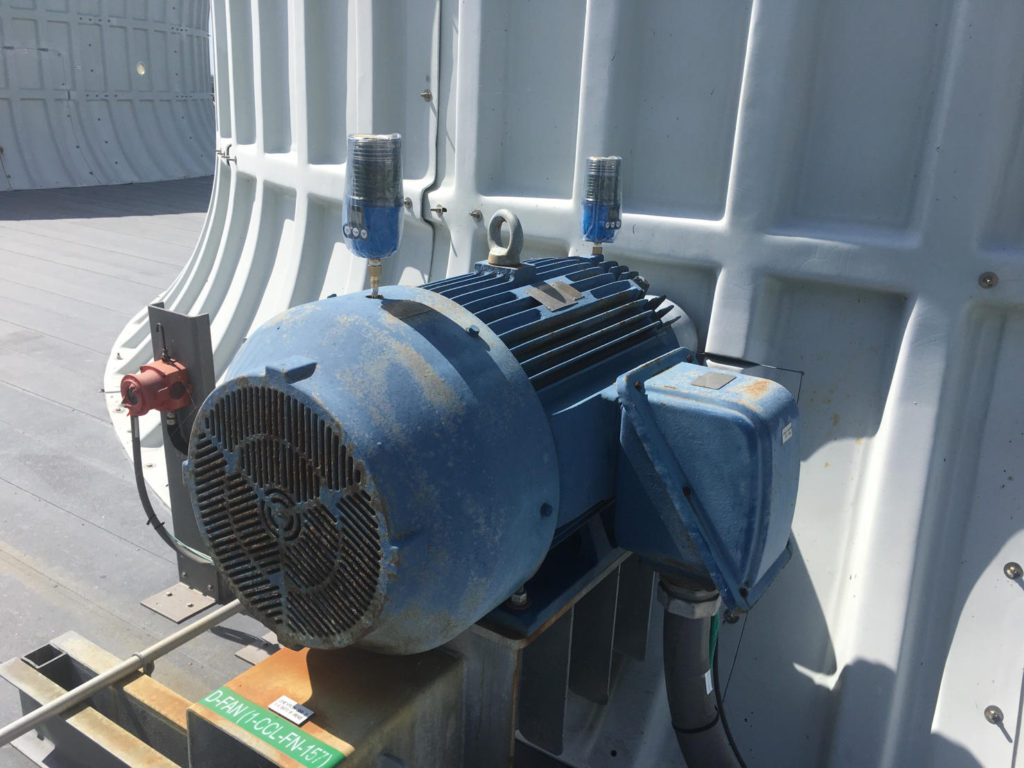
Synchronized units are available for standby equipment. Synchronized dispensers can be wired directly to the motor supply, junction box, or controller. Additionally, dispensers are also available with vibration sensing modules that will turn on the dispenser when the motor is energized.
Always use the lubricant designated by the manufacturer based on the bearing design, speed and temperature.
Selecting the correct base oil viscosity, NLGI grade, and thickener choice based on dropping point, oil separation and consistency stability is critical for long term reliability. In general, older technology EP #2 greases compromise motor longevity because sulfur and phosphorous additives can form corrosive byproducts when used in humid/wet services.
The general recommendation is to use a synthetic G IV, PAO base oil grease, ISO 100 VG viscosity, NLGI #2 grade for horizontal motors and NLGI #3 for vertical motors.
Modern grease technologies, additive designs, and thickeners can be selected with the help of your grease supplier if electric motor bearing life is compromised by corrosion, vibration, shock load, and water ingress. Polyurea, while the most common thickener, need not be the only thickener depending on service conditions. By conducting bearing failure analysis for rust, pitting, and spalling, you may uncover clues to potential lubricant performance upgrades.
Consult your manual or the manufacturer’s website to find out the proper interval for lubrication.
Lubricating too often or too little could also cause premature wear in your bearings if under lubricated, or cause degradation of the insulation around the winding if over lubricated.
The use of re-greasing tools, such as the Chesterton Precision Lubrication Tool,* calculates re-greasing quantity and frequency based on speed, temperature, contamination potential by water and abrasive dirt, vibration, and bearing position and type.
Often service intervals are increased or decreased based on the specific operating conditions and environmental exposure of the motor.
*Contact your local Chesterton representative.
2. Select the Best Type of Bearing for Your Application
Electric motor bearings maybe of several configurations. The specific bearing used in the motor is typically identified on the motor identification plate. However, it is best not to believe the information as, in many cases, motors have been rebuilt, and bearings maybe different from original OEM configuration. Each configuration imposes their own unique challenges to the bearing and lubrication requirements.
Electric motors use a variety of bearing types as listed below and are identified by an alpha code following the bearing reference number. For example, a bearing of reference # 6308, 6308Z, 6308ZZ or 6308RR would correspond to a bearings of the following type:
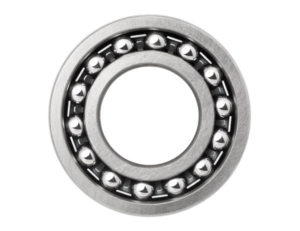
Open bearings
Open bearings consist of an inner and outer raceway, rolling elements, and the retaining cage. With an open design, there is no shield or seal. Lubrication grease freely passes through the bearing components, and the grease flows easily into the bearing. This design is advantageous because grease exchange during re-greasing is optimized. Therefore this bearing design runs cooler than other designs, allows for contaminants to be purged out easily, and requires lower grease gun pressure to introduce fresh grease. And because there are no shields, there is no concern of collapsing or pushing the shield into the rolling elements.
A disadvantage of the open design is also by-product of its greasing ease. Because the flow of grease into the housing is unrestricted, if greasing protocols are not followed excess grease can be pushing thru the housing and into the windings. In all cases, it is important to remove the lower grease plug and re-grease when the motor is running.
Shielded bearings
Shielded bearings have a thin metallic shield fitted into the bearing raceway opening or annulus. The shield has a small clearance on the inside diameter of 0.5mm or 1/32 in typically. This clearance offers some restriction to free flowing grease and exerts significant back pressure compared to the open bearing. The restrictive flow help prevent over greasing and grease being forced into the winding.
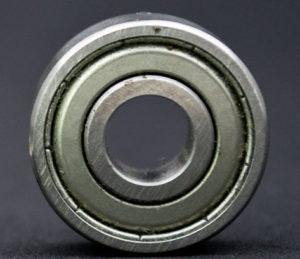
The shield may face inwards or outwards depending on electric motor brand or preference. Due to improper re-greasing practices of pumping grease in to the bearing too quickly, excess pressure may develop and collapse the shield onto the rolling elements. Care must be taken to follow the simple rule of 1-2 seconds between grease gun strokes and to grease while the motor is running. NEVER use an electric grease gun to grease an electric motor.
A disadvantage of shielded bearings is an increase in friction and temperature of the bearing. Shielded bearings run hotter than open bearings by up to 50°F/10°C. They require a very precise re-greasing procedure or guideline.
Double-shielded bearings
Double shielded bearings are similar to single-shielded bearing but include two shields (inner shield and outer shield). As expected, they offer more restriction to grease flow, turnover or exchange at re-greasing, and run hotter than single shielded bearings. The advantages of this bearing type are reduced particulate contamination and grease entering the windings. Disadvantages are heat, shield collapse, and extremely precise greasing routines/protocols.
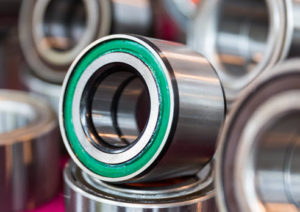
Sealed bearing
Sealed bearings are considered “lubricated for life” bearing. This is a misnomer in that they are lubricated for only the life of the grease. Their lifespan is typically much less than a properly lubricated open bearing. They have found acceptance at many electric motor repair shops and by OEMs for small Hp (Kw) motors due to the reduced costs of motor design and machining of the housing necessary for a greases bearing. A sealed bearing CANNOT be re-greased. As a result, any old grease, contaminants, or degraded lubricant cannot be purged out of the bearing. When the grease fails, so does the bearing and motor.
3. Prevent Bearing Failures
Bearing failures are one of the most common and easiest problems to prevent. If your bearings fail, there are multiple things that could go wrong with your electric motor. This section will go over how to inspect the bearings on your motor and prevent unnecessary wear to the bearings.
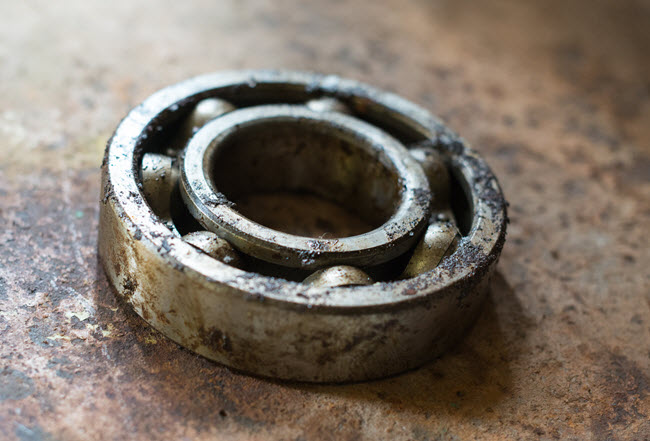
Alignment
Make sure the load attached to your motor is aligned properly. Misaligned loads can throw the rotation off balance, straining one or both bearings of the electric motor.
Operational Load
Ball bearings are susceptible to load related failure more significantly than roller and spherical roller bearings. Due to the smaller contact surface area, ball bearings are typically suitable for shock load, start and stop or vibrating conditions. Published L10 life of typical electric motor ball bearings can be rated at 25,000 hrs for “best case” conditions. A bearing L10 rating can be reduced to 1/8th of theoretical life with a 2X increase in operational load.
Vibration
Increasing vibrational impact will dramatically decrease bearing life. The American Bearing Manufacturers Association (ABMA) has estimated that a doubling of vibration can reduce bearing life by 75%!
Motors attached to drive pulleys with single and multiple V belts will side load the electric motor inboard bearing. Belt vibration will further expose bearings to damaging conditions. If these conditions exist, it maybe beneficial to select a grease with higher 4 Ball Weld Load rating, ASTM D 2596. A typical electric motor bearing grease has a 4 Ball Weld Load of 160-250kg compared to Chesterton 630 SXCF Grease and Chesterton 635 SXC Grease, which have a 4 Ball Weld Load of 620kg and 800kg, respectively.
Alternative technologies are available that can provide 250% to 400% higher load resistance and exhibit 4 Ball Weld Load of up to 800kg. Higher film strength and load resistance reduce the likelihood of spalling.
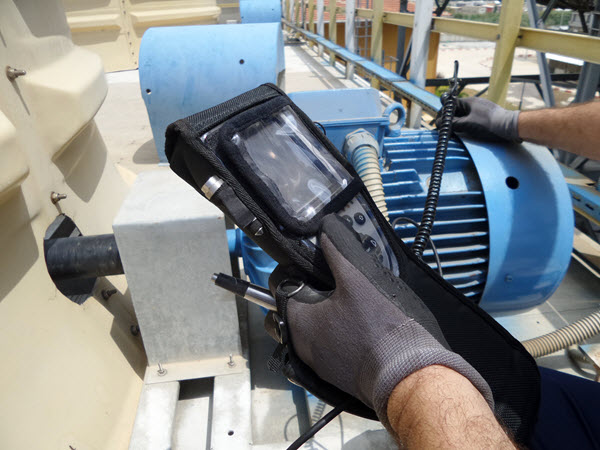
Contaminants & Cleaning
Keep the motor clean of contaminants and moisture. You may have to blow out the motor every so often to keep it free of moisture and small particles that could work their way into the bearings. Guard against water washdowns with full force water hose pressure.
If motors are covered with process debris, paper stock, minerals dust etc., clean using a mild detergent and low-pressure water rinse. Oily residues can be removed from windings with ultra-pure, high dielectric strength solvents. In all cases after cleaning of the housing, or windings, ensure surfaces are dry and bearings are re-lubricated before restarting the electric motor.
High pressure air or water blasting should be avoided. If water rinse off, sanitizing cleaning, or CPI processes are required, electric motor and equipment bearings should be lubricated with waterproof grease.
Compared to OEM-specified greases of 3-5% water washout per ASTM D 1264, advanced water-resistant technologies such as Chesterton 630 SXCF Grease and Chesterton 635 SXC Grease can protect and preserve the bearing surfaces due to water washout resistance of l< 0.5%. Improved water resistance works in conjunction with good seal design to keep water out of the bearing housing and prevents pitting corrosion.
Temperature Monitoring
Take temperature readings occasionally to monitor how warm or hot the bearings get. Compare those readings to the safe temperature range provided by the manufacturer (typically not to exceed 140-160°F. If the bearings are getting too hot, stop using the motor. Let it cool down and promptly inspect the bearings for damage or contaminants.
Over greasing causes as much heat generation as under greasing. Do not assume that excess heat is an over greasing issue. Consult your lubricant supplier and analyze the bearing operational conditions. In cases of excess heat, be mindful that greasing best practices suggest to re-grease when the motor is running and to remove the lower drain plug while introducing new grease. The grease plug can be replaced with an open port and tubing or a pressure relief port.
Noise Monitoring
If you hear any abnormal sounds coming from your motor, you can use ultrasonic detectors to better identify what part of the motor is creating the noise. Shaft seals and oil rings can contact the bearing housing and create noise unrelated to bearing condition.
We recommend a combination of ultrasonic and vibrational analysis monitoring. Listen for any abnormal sounds coming from the motor so you can address the issue before it does any further damage to the other components.
Check oil rings (if applicable) and keep an eye out for excessive shaft play. Excessive play in the shaft is a good indicator that you have a bearing that is defective or will be soon.
4. Monitor the Rotor and Stator Function
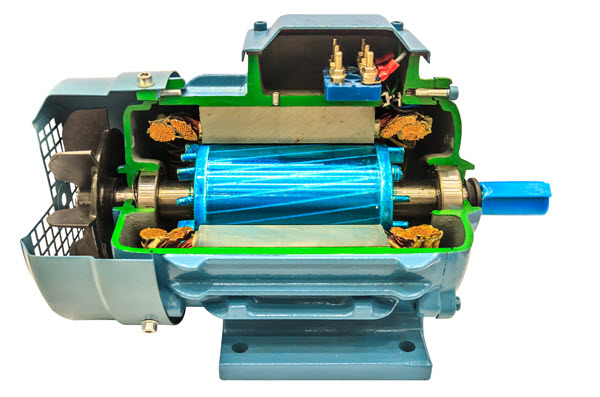
The rotor and stator are the heart of your electric motor. Without these components working properly, your motor will function very poorly or not at all. Here are a few pointers to help you make sure all is well with the rotor and stator.
Record the gap sizes at the top, bottom, and both sides at each end. Remember that bearings at rest will allow the rotary assembly to settle slightly due to diametrical clearances in the bearing.
Diametrical clearance is the total free movement of the inner race relative to the outer race in a radial plane, also referred to as radial clearance. “X” and “C” type bearings are made with some internal clearance as a standard factory internal fit before mounting.
Use a feeler gauge to check the gap between the stator and rotor for equal clearance all the way around. Eccentric motion may indicate bearing wear or misalignment of the assembly.
Compare any previous readings you may have to the manufacturer’s gap specifications. Any differences are a good indication that there is excess wear in your bearings and it may be time to replace those bearings.
5. Check the Motor Mount Condition
It is wise to inspect your motor mount on occasion to make sure it is still in good condition. A faulty motor mount can do damage internally to your motor and may even have an adverse effect on your load as well. ‘Soft Foot” is a condition where one or more mounting points become loose. This will cause a misalignment and enhance vibrational damage.
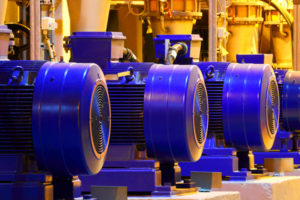
- Check the mounting bolts for proper tightness. If they are loose, tighten them up until there isn’t any play in the mounts. It is necessary to validate proper alignment before final tightening. Re-shin the motor as needed to maintain alignment.
- Make sure there isn’t any play between the mounts, whether it is between the plate and rubber isolation feet or between the plate and hard mount.
- Inspect the motor plate for any warping or cracks that could cause unnecessary flexing under load or at start up.
If it is mounted to concrete, check the concrete for cracking or chipping/erosion around the anchor bolts. If the concrete bases have corroded due to chemical attack, the use of chemical resistant mortars and grouts is recommended. Chesterton ARC coatings for concrete can be used to rebuild motor bases and concrete flooring.
6. Record Everything
It is essential that records be kept for your machines. It makes maintaining your machines that much easier and minimizes downtime. Best practices and repetition of successful process and procedures are important for sustainability.
- Document everything! That way you know exactly what is going on with your motors.
- If there are any symptoms that repeat, it will be easier to solve the problem the next time it occurs.
- Keeping records will also help figure out the common problems so you can have backup parts if needed.
- You might eve notice a pattern, so you can preemptively address a problem pattern.
Bearing reliability is essential to motor reliability and your plant achieving operation goals and performance efficiency.
Use this blog post as a guide when it comes to maintaining your electric motors. By following the items addressed above, you should be able to optimize the performance and prolong the life of your motors.
Chesterton has targeted solutions that have documented cost reducing performance and user friendly implementation procedures for extending bear life and motor reliability.
Contact a Chesterton Application Engineer for more information.
For more information:
- Related Post: The Basics of Industrial Lubrication

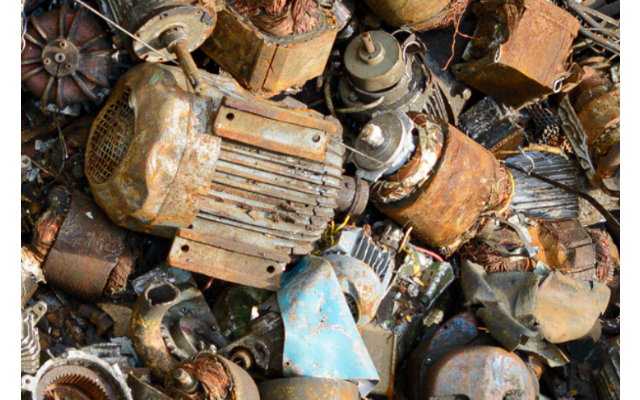
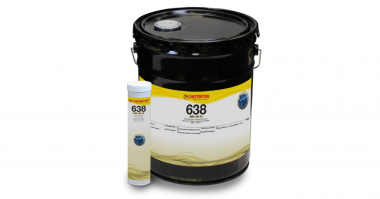


Comments